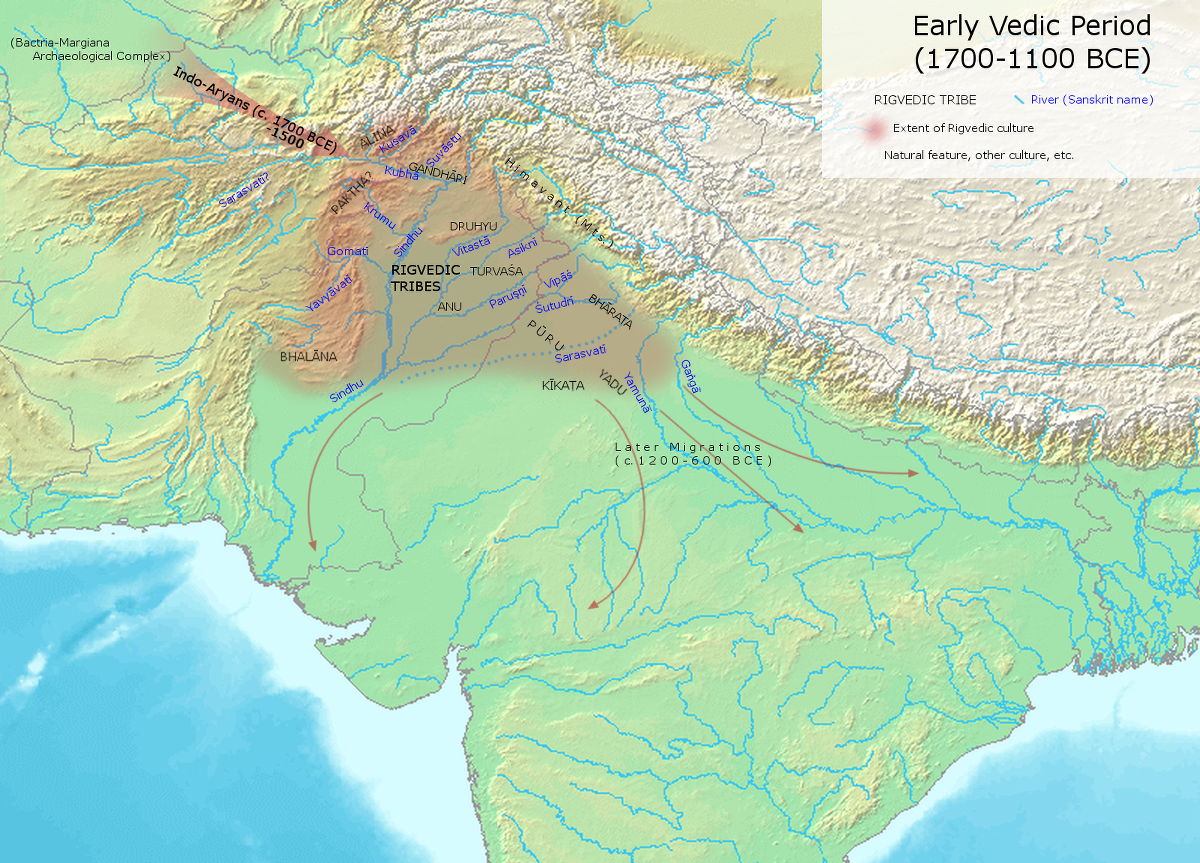Skip to content

- The main source of information for the reconstruction of the Early Vedic age is the Rigveda. Vedic literature is the most significant source of information about the Vedic civilization. The Rig-Veda is the oldest religious text in the world and it contains 1028 hymns and is divided in ten mandalas. The tenth mandala contains the famous Parushasukta which explains the four Varnas (Brahmana, Shatriya, Vaishya and Shudra).
- The Rigvedic’s earliest text Samhita comprises 10 books or mandals of which: (a) Books II to VII are considered to be the earliest and belong specifically to the Early Vedic (b) Books I, VIII, IX and X are considered to be late additions to the Samhita.
- The Vedic literature consists of three successive classes of literary creations, namely –
- Vedas
- Brahmanas
- Aranyakas and Upanishads
Vedas
- Veda means “knowledge“. The Vedas formed the earliest segment of Vedic literature.
- The Vedic literature had been evolved in the course of many centuries and was handed down from generation to generation by the word of mouth.
- The Vedas are the collection of hymns, prayers, charms, litanies, and sacrificial formulae.
- Vedas are four in number, namely −
- Rig Veda − It is the oldest Veda. It is a collection of hymns.
- Samveda − it is a collection of songs, which are mostly taken from Rig Veda.
- Yajurveda − It is a collection of sacrificial formulae.
- Atharvanaveda − it is a collection of spells and charms.
Brahmanas
- The Brahmanas are prose texts. It describes about the meaning of Vedic hymns, their applications, and stories of their origins in details. Besides, it also explains the details about rituals and philosophies.
Aranyakas and Upanishads
- Aranyakas and Upanishads exemplify philosophical meditations of the hermits and ascetics on soul, god, world, etc. These are partly included in the Brahmanas or attached, and partly exist as separate works.
- They, the Brahmanas, the Aranyakas, and the Upanishads are attached to one or the other of the four Vedas.
- Compositions of the hymns are credited to Hindu Rishis (monks) of divine origin.
- The Vedas are called ‘apaurusheya’ (not created by man) and ‘nitya’ (existing in all eternity) while the Rishis are known as inspired seers who received the mantras from the Supreme deity.
Age of Rig Veda
- The origin of the earth goes back to about 4,600 million years and the origin of humans themselves goes back to about 4.2 million years (ago).
- Max Muller gives arbitrarily the date of composition of Rig Veda to be around 1,200 to 1,000 B.C.
- D. Whitney negated and criticized Muller for using totally arbitrary, unscientific, and un-academic method in assigning the dates.
- On the analogy of the language of Avesta, some scholars opined that the date of Rig Veda may be 1,000 B.C.
- Some of the Vedic gods namely Indra, Varuna, Mitra, and the two Nasatyas were mentioned in Boghaz-Koi (Asia Minor) inscription of 1,400 B.C., which proves that Rig Veda must have come into existence much before the date described by some of the foreigner scholars.
- The Boghaz-Koi inscription records a treaty between the Hittite and the Mitanni Kings and the gods (mentioned in the above point) were cited as witnesses to this treaty. Even today, exactly in the same way, the oath is taken in the courts and on an assumption of a public office (in the name of god).
- Bal Gangadhar Tilak, on astronomical grounds, dated Rig Veda to 6,000 B.C.
- Harmon Jacobi held that Vedic civilization flourished between 4,500 B.C. and 2,500 B.C. and the Samhitas were composed in the latter half of the period.
- Famous Sanskritist, Winternitz felt that the Rig Veda was probably composed in the third millennium B.C.
- K. Mukerjee suggested that “on a modest computation, we should come to 2,500 B.C. as the time of Rig Veda”.
- C. Pande also favors a date of 3,000 B.C. or even earlier.



